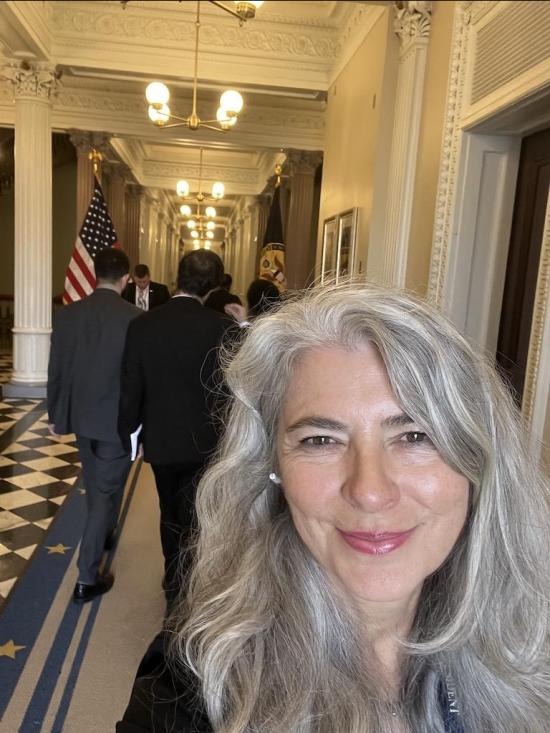After two years at the White House’s Office of Science Technology and Policy (OSTP), where she served as Deputy Chief Technology Officer for Policy and then Principal Deputy U.S. CTO, Professor Deirdre Mulligan returned to the I School this fall. We asked Professor Mulligan about her experience at OSTP, how her experience changed her views on tech policy, and what’s next.
How was your experience working in the Office of Science and Technology Policy (OSTP)?
My work at OSTP was a highlight of my career. I had the opportunity to work on topics ranging from AI to spectrum to equitable data. I encourage all academics to look for a way to serve in government at some point in their careers using opportunities like sabbaticals or fellowships. The interdisciplinary expertise that I Schools cultivate is particularly important today as governments at all levels are seeking to use technology and data to deliver public services, and to regulate increasingly data-driven and technology-driven marketplaces. For academics, government service is an important way to bring insights from their research–which is often funded by public entities–and that of the fields and disciplines in which they are situated into policy processes that impact millions of people across the country.
What was your day-to-day like?
It was very fast moving. Many things on the Administration’s agenda touched on information, communication, and technology — everything from the new web accessibility rules under the Americans with Disabilities Act, to the way the administration uses data to show how programs like the Inflation Reduction Act (IRA) impact every American, to seize the possibilities of AI and protect the public’s rights and safety whenever AI is used. On a daily basis we were providing input to the director of OSTP, and advising other members of White House senior staff on a wide range of issues.
In the White House, things can move really fast and multiple important decisions are being made every day. Being able to quickly pull together expert material and guidance to inform a decision is an important skill. I was delighted to have a team with diverse expertise and experiences–the kind of people that you would find at the I School — technologists, computer and data scientists, social scientists, and lawyers–, who thought about AI and technology through the lens of equity, human rights, and safety in various contexts including labor, healthcare, broadband, etc.
It was tremendously helpful to be able to bring all that expertise in to facilitate the administration’s decision-making.
During your time working at the OSTP, you went from Deputy Chief Technology Officer to Principal Deputy Chief Technology Officer. How did working in these roles affect your thoughts on tech policy?
It was nice to start as a deputy because it was my first tour through the White House. In that role, I was responsible for a slightly smaller portfolio. I was working on AI partially, but also privacy, spectrum and broadband. When I took over as Principal Deputy, I was managing a much bigger staff that included, at the height, four or five deputies underneath me who each led a team working on a specific portfolio.
I was an expert in some areas and familiar with the full range of substantive policy issues my team covered, but I was not as familiar with the processes — both the interagency process, which is how federal agencies weigh in and voice opinions around federal policy, and the processes within the executive office of the president.
What projects did you work on during your time at the OSTP? What achievement are you most proud of?
My team contributed to many important Administration actions. Two that might be of particular interest to the I School community are the ADA web accessibility rules I mentioned earlier and the suite of actions the Biden-Harris Administration took to advance the responsible use and governance of AI.
The new ADA web accessibility rules are the first update in 25 years. It’s a historic civil rights achievement. I hope it will usher in a time where everything that is digital is born accessible.
COVID really drove home the importance of the accessibility of our digital platforms and particularly how governments make information available to the public. It also made apparent that we need widespread broadband access. We need to make sure that technology supports the needs of all Americans, and accessible technology and broadband deployment are key components.
People often think that the accessibility of tech affects just a small portion of the population. However, nearly 50 million people have vision, hearing, cognitive, and manual dexterity disabilities. The new regulations will ensure every member of the public can access state and local government services, like transit information and voter registration portals, and educational opportunities. Universities and state and local governments have an opportunity to lead on digital accessibility and pave the way toward a future that makes good on our goals of inclusivity and justice for all Americans.
Second, last October President Biden signed the landmark Executive Order on the Safe, Secure, and Trustworthy Development and Use of Artificial Intelligence. The Executive Order on AI lays out an ambitious agenda for the United States—it directs federal agencies to establish new standards for AI safety and security, protect Americans’ privacy, and advance equity and civil rights—it stands up for consumers and workers, promotes innovation and competition, advances American leadership around the world, and more.
Congressional inaction made the administration’s actions on AI all the more important. Many people are talking about the risks and the possibilities of AI. The Biden-Harris Administration went to work setting the US government on a path to managing the risks of AI and using AI to benefit the public.
The Executive Order called on agencies throughout the US government to use their authorities to make sure that AI in the commercial marketplace is mitigating risks and being used in ways that are appropriate for the purposes. The administration is modeling how to design and use AI responsibly and protect the public’s rights and safety with new guidance to federal agencies on the responsible use of AI–the M-24-10 memorandum. That document sets out the most rigorous set of evaluation standards for AI–covering data, algorithms, and operational systems, and requiring oversight, and public participation by affected communities–anywhere. We have an opportunity to show that when we develop and deploy technology with attention to equity, privacy, inclusivity, and public purpose, we can do big things.
Another important feature of the AI Executive Order was the AI and tech talent search. This is the first executive order in history to include a whole section on talent. The Administration was keenly aware of the fact that we’re not going to be able to use or regulate AI if we don’t have the right kind of talent.
My team at OSTP was very involved with the Administration’s AI actions including the tech talent surge and when I left on July 31st, federal agencies were on track to hire hundreds of new people by the end of the summer. This is a huge influx of vital talent into the government at a critical.
What are you excited about now that you’re back?
I have always known that this school and other I Schools that provide interdisciplinary education produce the people who are really important for the government to have on staff. I’m even more certain now than I was before I went to [Washington] D.C. that we have an incredibly important place in the tech policy ecosystem.
We have students who understand something about the law, about how individuals interact with technical systems, and can shape how systems are deployed and impact people in practice.
People who do that sort of work in a meaningful way is something that governments all across the globe need. I am super interested in continuing the tradition of interdisciplinary education and making our programs more visible because I think that our alums have a really important role to play in the world today.
We’ve always been small, but we punch way above our weight. Many of our Ph.D. and master’s alums play an important role in tech policy, inside and outside government, including in industry and civil society.
Do you have any advice for students interested in pursuing a career in tech policy?
This is your moment. Look for programs that are interdisciplinary, emphasize experiential learning, and will expose you to work across all sectors.
You can be a technologist, but you need to know enough about how humans interact with technology and how policy interacts with technology to really position you for leadership opportunities. If you can work with a state or local government or the federal government as an intern or an extern or you have the opportunity to work at a civil society organization focused on public policy, do it.
Getting on-the-ground experience helps you situate yourself because you’ll be working with people with a diversity of expertise. You’ll learn how to build bridges and communicate with the disparate experts you'll be working with and the diverse people you’ll be working to serve.
How does the I School prepare students for this field?
The I School sets students up very well to participate in tech policy and, in particular, the growing field of public interest technology. It does that in two ways: First, many students who come to the I School have a real interest in the intersection of technology, people, and society. The orientation of your peers in this program is likely to be broader than you might get in a more traditional technical-only program.
Second, faculty and students come here because they’re interested in research and practice in that intersectional space. The projects students do and the teaching they’re exposed to ask them to take a 360 on a problem and to consider the technical, legal, policy, social, and organizational aspects.
It’s just the perfect environment to gain the knowledge and develop the skills to have an impact in tech policy no matter what path you choose.










